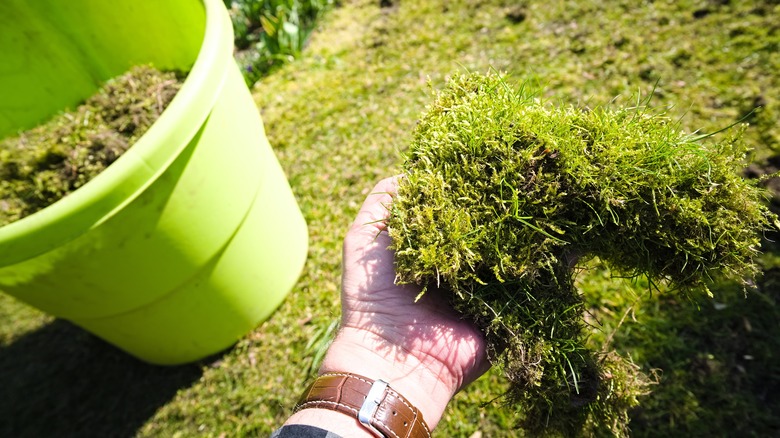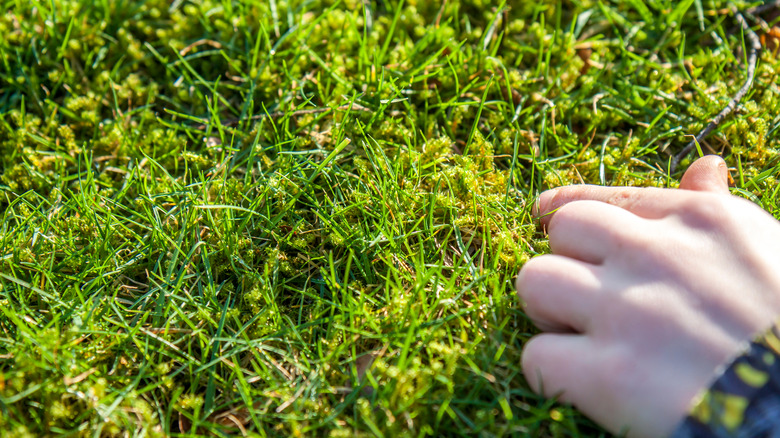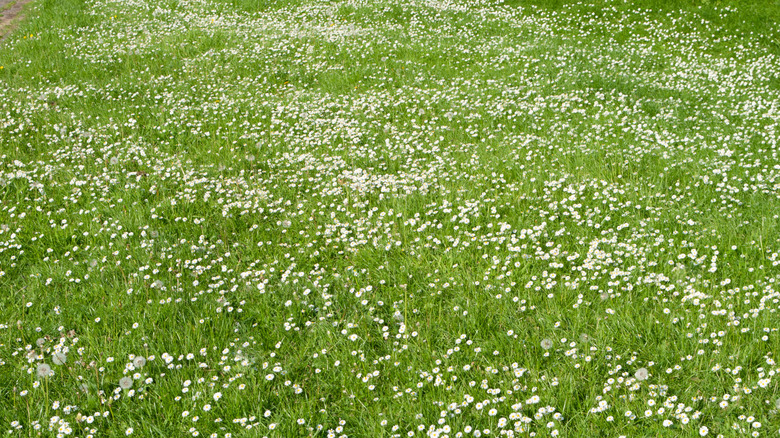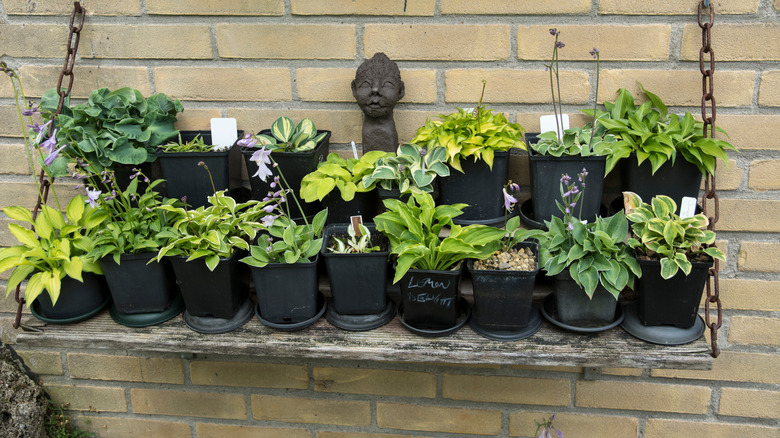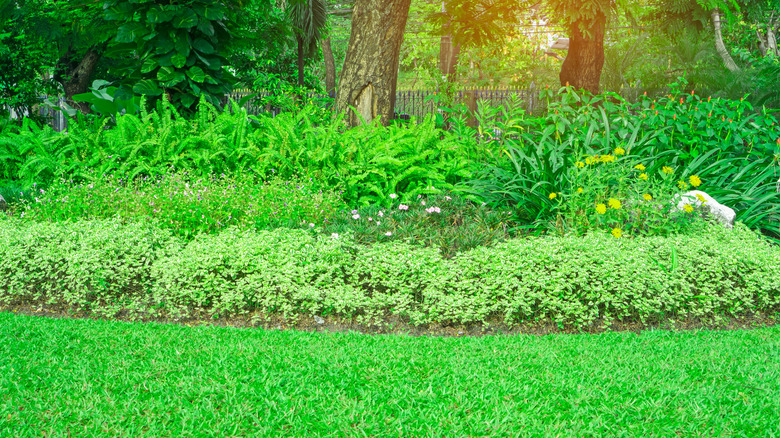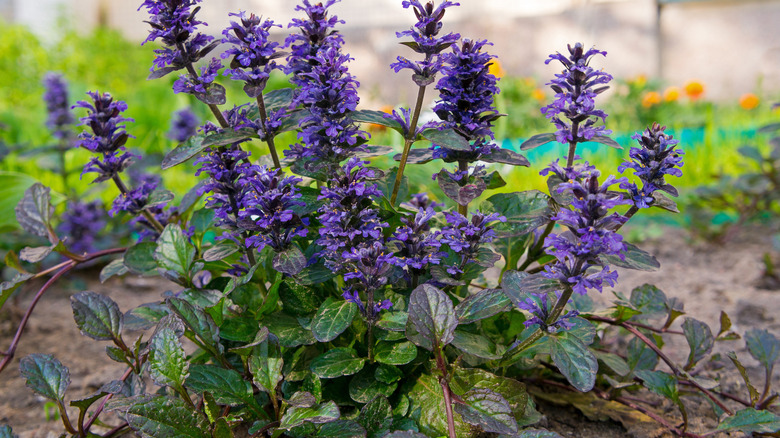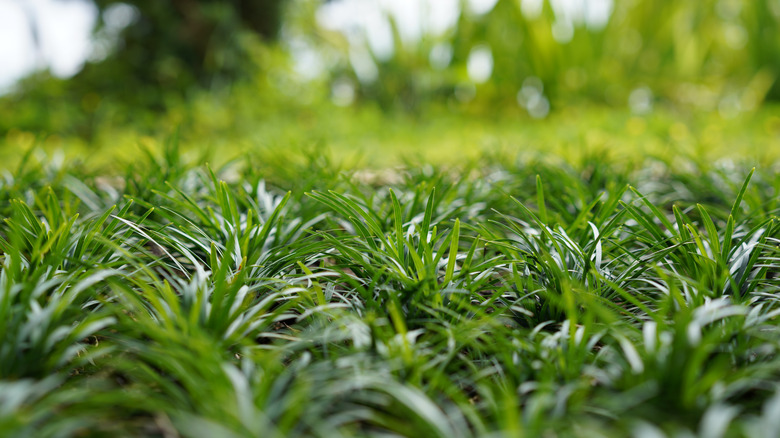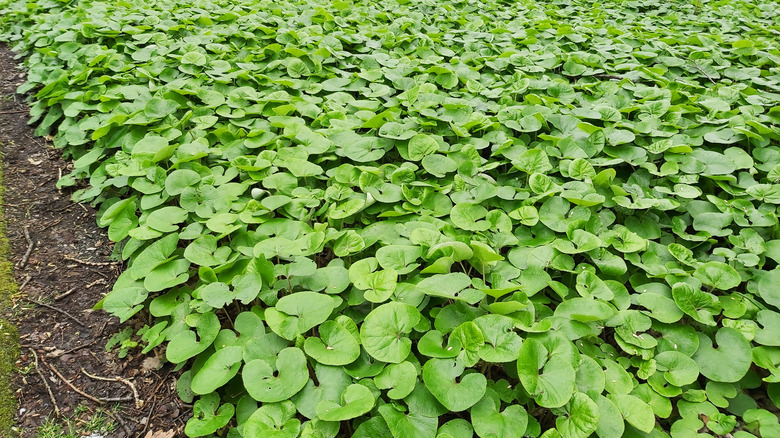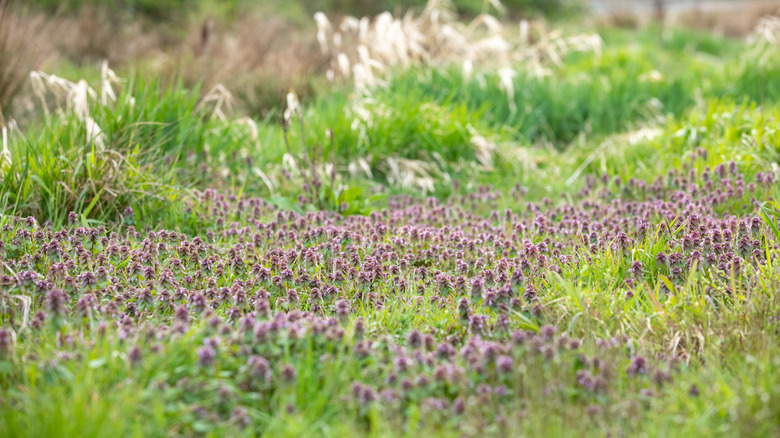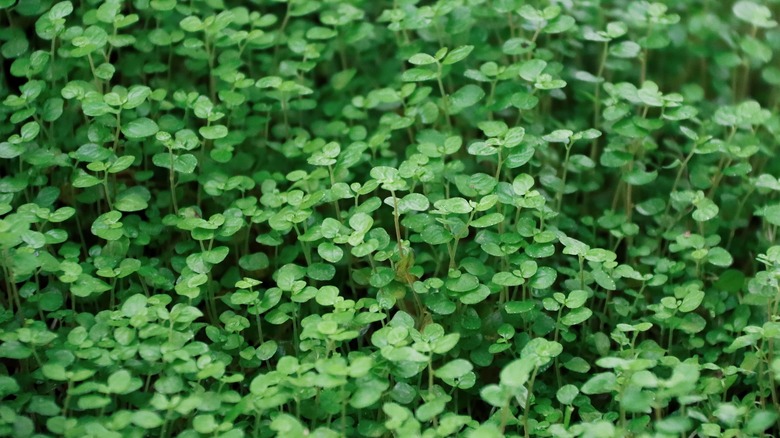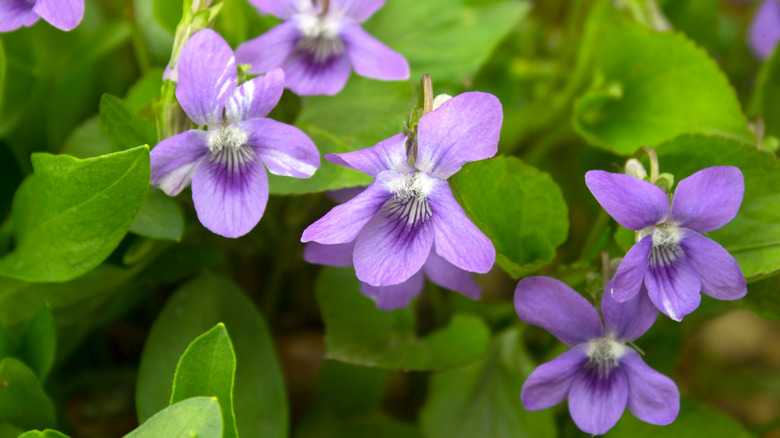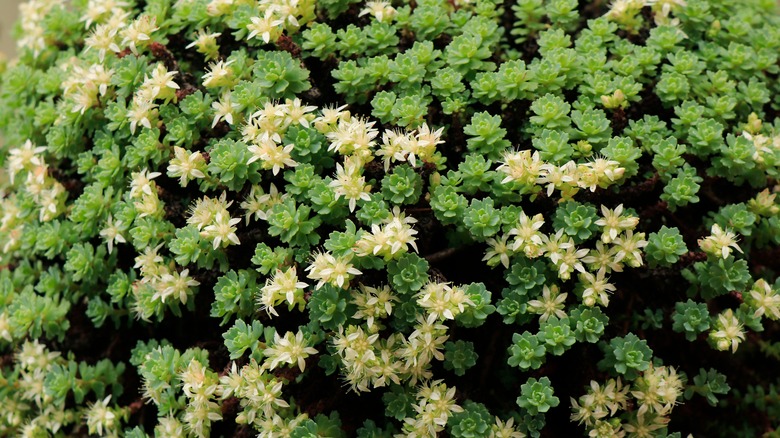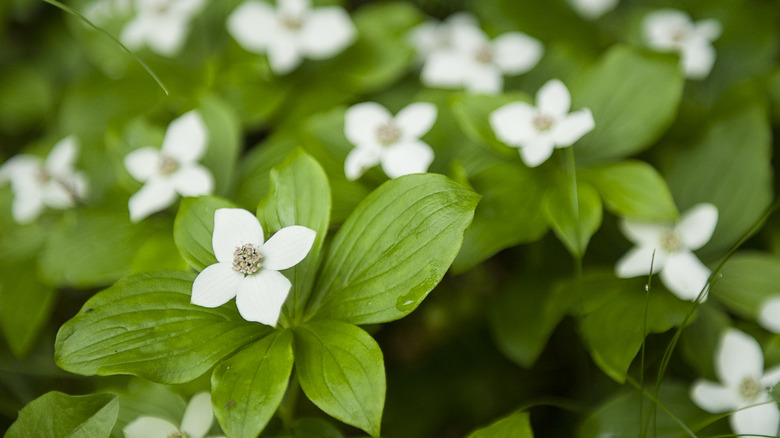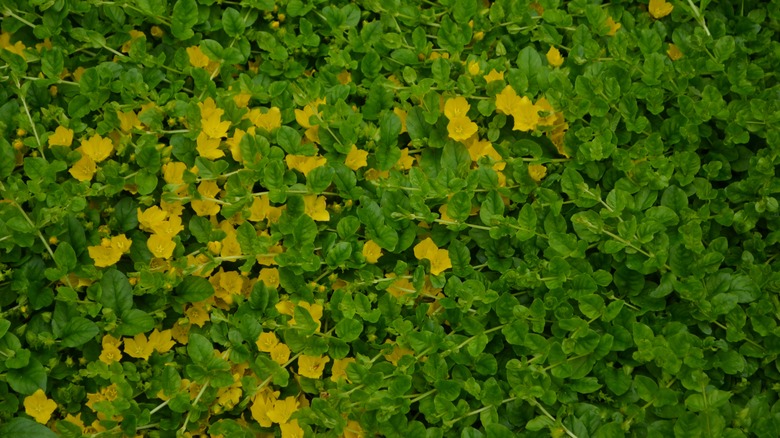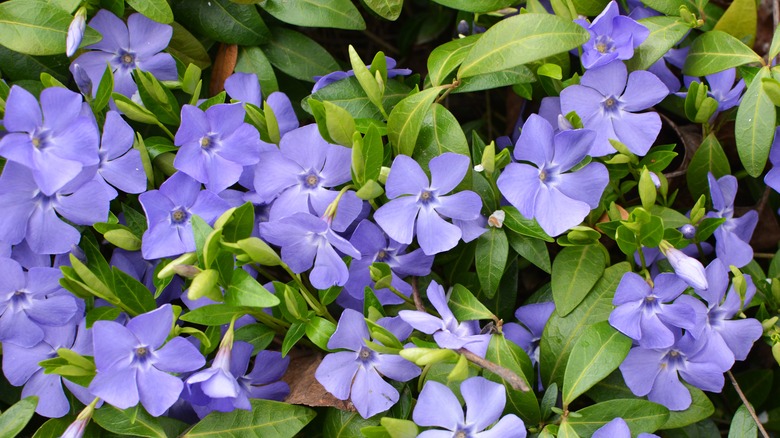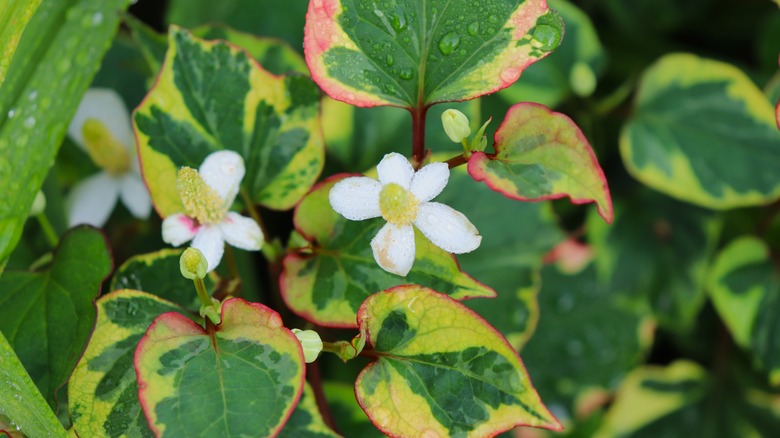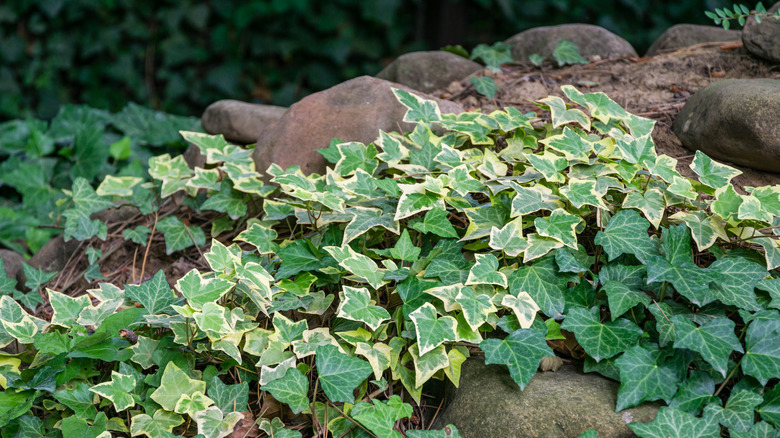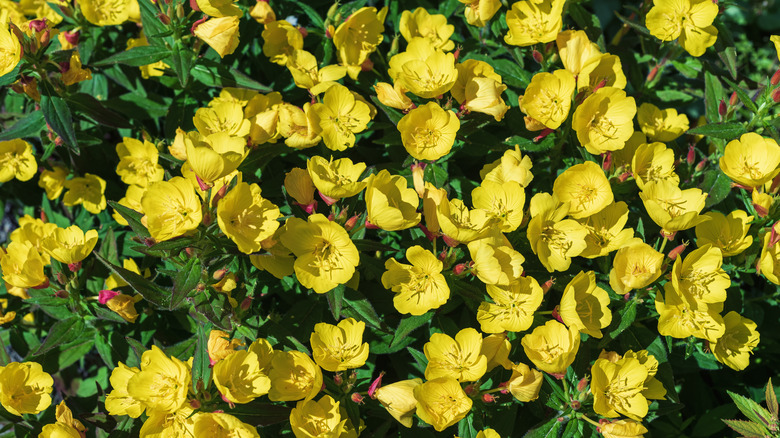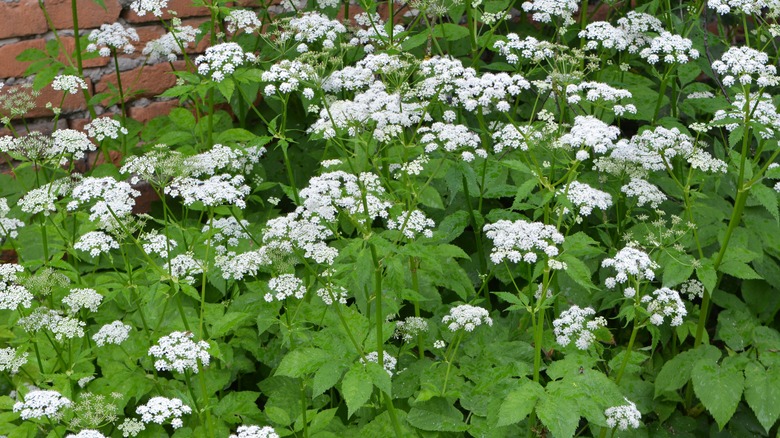Stunning Lawn Alternatives For Your Shady Backyard (& Which Invasive Plants To Avoid)
You've probably looked for hacks or tricks to help you get a stunning-looking lawn, especially if you have a mostly shaded yard. However, what you may not have considered is having alternatives to traditional grass throughout your yard. Many of these picks thrive in full or partial shade, and a lot of them don't even need routine mowing because they only get a few inches tall. This frees up your time to use on other gardening projects or for simply being outside and enjoying the sunshine.
This may be a shift because it's common to think of a lush, sun-drenched grassy yard as the epitome of beauty. While this is fine, you may fight with shadowy, dim corners where grass struggles to take hold, and you end with brown, patchy spots. We're inviting you to forget fighting with your grass and focus on ground covers that transform your shady yard into a vibrant spot packed with textures and colors.
Whether you fall in love with the evergreen, lush look of moss or the delicate coloring with violets, each alternative can bring something extra to your yard. Along with highlighting them, you'll find out how they cut down on your lawn maintenance routine to give you some of your precious time back while keeping your yard looking full and healthy all season long. We'll also share some invasive plants you'll want to avoid when planting a lawn alternative.
Moss thrives in shaded, damp spots
Moss is a lush, green grass alternative that is easy to take care of and very popular for any spots where grass struggles. Unlike traditional grass, moss loves dense shade and grows into a thick green carpet. Moss works wonderfully if you live in humid woodland regions but struggles in drier climates unless you have a watering routine to keep it hydrated. Moss isn't aggressive and won't damage your other plants, but it must have acidic soil. There are also various moss varieties you can choose from, so think about how much traffic your lawn gets before deciding on one.
Maintaining your moss lawn is simpler than a grass lawn. You won't have to mow it, and it has lower watering needs except during dry spells. Water well during those times so that the moss doesn't dry out and turn brown. Remove leaves and debris in the yard so that they don't suffocate the moss. If you have bare spots, spread a slurry of water and moss fragments over the area to encourage it to spread. Since the roots are so shallow, you only have to ensure the top inch of soil has a pH between 5.0 and 5.5. Test the soil every few weeks and adjust the pH as needed to stay inside this range.
Sweet woodruff forms a thick groundcover
Sweet woodruff is a lovely groundcover that prefers shaded areas in the backyard where grasses fail to thrive. It has small, star-shaped blossoms and, if you dry them, scented leaves that smell like just-cut hay. It grows in cooler environments, especially north-facing gardens or beneath trees. It isn't invasive, but it can quickly take over spaces intended for different shade-loving shrubs or blooms. If you have hot summers, sweet woodruff may struggle if it gets direct afternoon sun because it prefers temperate climates.
This low-maintenance groundcover prefers to be in well-drained, moist soil, and you'll need to water it at least once or twice a week. During dry spells, monitor the soil and ensure it stays damp to keep it healthy. Put a thick layer of mulch down to help lock moisture in the soil and keep the roots cool. You may be able to skip fertilizer altogether because it does well in poor soils. You also don't have to prune it unless you want to encourage denser growth or control where it spreads, and trimming it back after it flowers in the spring will accomplish this. Divide sweet woodruff every few years in the fall to help manage where it spreads and renew older plants.
Mini hostas group tightly for a no-mow lawn
Mini hostas are a small and vibrant option if you don't want traditional grass, and they work wonderfully in shady corners of your yard. Known for having lush, small foliage and being grouped together, they give you a practical, eye-catching no-mow lawn. They're available in shades of green, and you can find variegated versions for visual interest. They adapt to a broad climate range but thrive if you get moderate to cool summers. You'll also want to keep them in spaces where you rarely walk on the lawn because damaging their foliage is easy. They're a favorite food source for deer or slugs, and you'll have a problem if you don't safeguard against them. They will scorch in full sun, so keep this in mind when choosing your lawn alternative.
These tiny plants thrive in organically rich soil that drains well, and mixing compost into the soil before you plant them gives them a strong start. You'll need to water to ensure the ground is damp but not soaked, so keep tabs on the conditions and make modifications accordingly. Mulching around the hostas is a way to retain moisture in the soil and lower weed growth. To protect them from deer and slugs, consider adding certain kitchen scraps to ward slugs away or applying eco-friendly deer repellents. Add a balanced slow-release fertilizer in the spring, and routinely remove dead or damaged foliage.
Hardy ferns add texture and height to your lawn
Hardy ferns are one way to flip your yard's look and feel. They have varying heights, offering an explosion of texture. These are resilient plants that grow in partially or fully shaded spots where grass may struggle. There are dozens of species, and each has a unique look ranging from lacy, delicate fronds to architectural, bold leaves. They're great for helping you get a forest feel and are generally safe to have around other plants. Ferns need specific conditions, like a moist, cool growing zone, to do well. Ferns are also delicate and won't survive with heavy foot traffic. Before you pick this lawn alternative, ensure you can meet their needs so that you don't run into problems.
These plants need consistently moist soil, so you'll need to water them regularly to ensure they don't dry out — although you do want to avoid waterlogging as this can harm their growth. Adding a layer of mulch around the base can help reduce temperature fluctuations and retain moisture, giving the root stability. Ferns need rich soil with a lot of organic matter. Carefully walk through and snip off damaged or dead fronds in the spring to encourage healthy new growth and improve air circulation. You usually won't need fertilizer, but you do have to protect them from too much sun and wind exposure as harsh conditions can scorch or tear the fronds.
Bugleweed is a fast-growing weed suppressant
This lawn alternative gives you pretty blue flowers and glossy foliage. Bugleweed is a hardy ground cover that's deer-resistant and will help choke out weeds. It has a reputation for spreading quickly, covering your garden with thick, mat-like foliage. It loves shaded or partially shaded spots, making it great for under trees where grass struggles to grow. The aggressive growth pattern means it can be invasive and easily outcompete your other plants. It also struggles to grow in very hot or dry environments. So before you plant it, you have to ensure that you keep it contained so that your other shrubs or plants stay healthy and thrive alongside it.
Caring for this plant involves having strict boundaries to prevent it from taking over. Using a physical barrier or garden edging can help control the growth. It also prefers well-drained, moist soil, but it can also grow in alkaline and acidic soils. You'll only have to water during drought conditions to keep it vibrant, especially once it establishes strong roots. You also don't have to fertilize heavily to get a strong plant. Prune the foliage in late fall or early spring to keep it looking good and not spreading too far. Also, divide bugleweed every few years to breathe life into dense patches.
Mondo grass is an evergreen, mat-like lawn alternative
Mondo grass is an evergreen lawn alternative that grows into a mat-like, low-maintenance yard. Unlike traditional grasses, this one forms dense clumps of dark green, slender leaves that grow well in spots with no sun. This ability allows you to plant it under trees or in north-facing gardens where other plants will struggle. Since it's evergreen, it'll keep your yard looking beautiful all year round, and you'll skip the dead patches that traditional lawns sport during winter.
Since this grass prefers shade, plant it in areas where it has cover from the intense afternoon sun. It's also susceptible to root rot, so ensure that the substrate drains correctly; adjust as needed to boost the grass' health. Water it multiple times every week to retain the soil's moisture levels until it's established; then drop it to once a week when it does not rain. Give it a light dose of slow-release fertilizer in the springtime to promote vigorous growth, and trim it carefully once every year to eliminate any dead or damaged leaves.
Canadian wild ginger is a hardy, deer-resistant groundcover
Canadian wild ginger is a deer-resistant, hardy plant that'll thrive under a pine tree and in other shaded yard areas. It has heart-shaped leaves that form a dense mat that covers the ground, and it's a native plant with flowers hidden under the foliage that attract insects. However, even though it can adapt, it prefers to be in spots that mimic its native woodland settings, and this means it needs well-drained but consistently moist and rich soil. It won't do well planted in overly sunny spots, and it'll require more care to keep it from scorching. It only grows six to eight inches yearly, so it'll take a few years to spread over the yard.
Water during dry periods to keep the soil moist, especially during the first two or three years, to encourage deep roots. Add organic material to the soil to mimic leaf litter to help improve drainage and add nutrients. Also, putting in a layer of mulch will help prevent weeds and give the roots a temperature buffer during hot weather. Prune throughout the year to remove damaged or dead leaves to encourage new, healthy growth.
Deadnettle is a versatile, blooming, thick groundcover
Deadnettle has a reputation for filling in shaded spots by growing thick foliage. It produces many flowers, ranging from pink to purple, which add a beautiful pop of color to your yard during spring and summer. It grows exceptionally well under trees or in spots where grass looks patchy, but there are a few things to consider. While it's not invasive, it can spread very quickly and overtake smaller plants. To control the deadnettle in your lawn, you want to take steps to contain it or plant it in an open spot away from other flowers, shrubs, or trees.
Along with keeping it in the shade, ensure the soil is moist at all times. It can tolerate various soil types but produces the most flowers in a rich, well-draining mix. Adding compost when you plant supports strong growth, and deadnettle likes a light layer of mulch to help suppress weed competition, lock in moisture, and keep the roots cool. Trim back any spent blooms to encourage a second round of flowers and keep it looking tidy. Every few years, divide the plants in early spring or late fall to help manage the spread and encourage new, healthy growth on older clumps.
Plant Corsican mint to enjoy a fragrant and visually appealing lawn
Tiny pale purple flowers emerging from rich green foliage – what's not to love? Not only is Corsican mint (Mentha requienii) pretty to look at, it's got quite a few other benefits as well. With each step, this variety releases a minty aroma that smells delicious to us while repelling some common pests, like rodents. Plus, the tiny blooms attract butterflies and bees, making it a perfect fit for those wanting to start a pollinator garden. Although you may have been warned about growing any plants in the mint family (Lamiaceae) due to their invasive nature, this relative is a bit different from the rest. Many experts agree that despite its ability to spread, it's easier to control than its other plant relatives. That said, it's considered invasive in the Southeastern part of the United States.
Corsican mint can do well in a variety of conditions. While it can tolerate full sun, it does best in shady yards. You can grow this minty plant in nearly any type of soil as long as it's well-draining and stays moist. It's not very drought-tolerant, but you also need to be careful not to overwater, as it can lead to root rot. It's best to give it a good soak after the soil is completely dry. Because it doesn't tolerate overwintering in cooler climates, this ground cover is best suited for hardiness zones 7-11.
Violets form a colorful, low-growing lawn
Violets are a charming, low-growing, colorful lawn alternative for shady gardens or yards. They produce vibrant flowers in varying hues (including blue, purple, white, and yellow) to add a burst of color in early springtime. They thrive in full or partial shade, especially under trees or in shadowy spots by your house. They spread quickly to create a dense carpet, and they can self-seed, allowing them to pop up all over the yard. They may also be strong enough to outcompete other low-growing plants or flowers, so monitor them if you have other plants nearby.
Violets require well-drained but moist soil to grow. They survive in a range of soils, but adding organic mulch can boost flower production. Mulching around them will help lock in moisture and suppress weed growth, creating the ideal environment for them to spread. Divide thick clumps every year or two in the spring to help manage their spread and encourage new growth.
Opt for creeping sedum for a drought-tolerant ground cover
Sedum, also known as Stonecrop, is a genus with over 400 species to choose from. While some produce flowers, its their foliage that's the real star of the show. Its fleshy leaves come in shades of red, pink, purple, blue, green, and chartreuse, with some with a combination of colors. Additionally, there are several unique shapes and sizes that make them even more aesthetically appealing. These low-growers spread rapidly, though they aren't invasive. Even if they expand a bit more than you'd like, their shallow root systems make them easy to remove and keep under control. As a bonus, this lawn alternative is relatively deer-resistant because the thick leaves have a bitter taste. However, deer will munch on nearly any plant if they're hungry enough. On the plus side, even if an animal does snack on its leaves, this self-propagator will regrow.
Creeping sedums make incredible ground covers in hot, arid climates. While dry, rocky soil isn't the most ideal growing medium for most plants, stonecrop thrives in it. Technically succulents, these plants rarely need water unless it hasn't rained in a few weeks. Like other self-spreading plants, you can use plugs and watch as they grow and take up large areas. While they prefer full sun, they can tolerate some shade. However, if you're in a cooler zone, planting them in a sunny location improves the chances of successful overwintering.
Grow bunchberry for a thriving plant in shady yards
Equally beautiful in fruit and flower, bunchberry (Cornus canadensis) makes an excellent ground cover that forms a relatively dense carpet along the yard. It features vivid green foliage that fades into a brilliant red in the fall. Atop the leaves it blooms tiny white flowers in late spring before producing bright red berries mid-summer. Native to North America, this eco-friendly plant attracts several pollinating insects like bumblebees, and its edible berries will bring more birds to your garden. Not only are they a great snack for our flying friends to munch on, but they also provide several benefits for humans.
One of the biggest pros of using bunchberry as a ground cover is its low growth habit, only reaching a maximum height of about 8 inches. However, it's often quite a bit shorter than that. Finding the right lawn alternative for a shady yard can be tricky, but another plus side of bunchberry is that it not only handles shady conditions but thrives in them. It's also extremely weather-tolerant and can easily withstand harsh winters. That said, this cold-living plant doesn't tend to do well in areas with hot summers. Although it spreads via rhizomes, it expands at a moderate pace and isn't considered invasive. This species loves moisture, so make sure to give it a good soak when the soil gets dry.
Creeping jenny aggressively spreads to cover the yard
Creeping jenny is a pretty lawn alternative with gold or vibrant green leaves and a fast growth reputation that will overtake your shady backyard to get a carpet-like look. It grows coin-shaped foliage that lends a pop of color and texture, which is perfect if you don't have bright plants. However, its fast development means that unless it's controlled, it gets invasive and is capable of taking over other vegetation in the garden. If you have hot, dry weather, you'll need to be vigilant about watering to keep it from withering and dying. Before you plant it, consider your yard or garden's layout and proximity to natural areas because it can quickly spread far enough to impact local ecosystems.
Creeping jenny is low-maintenance, but you'll have to take time to ensure it stays inside a designated area. Installing physical barriers, like a fence or edging, can help keep it in your yard. It thrives in moist conditions, so watering it every day or two during droughts is critical to keep the soil damp. It can adapt to various soils, but it loves well-drained, rich planting material. Trimming it back in early spring or late fall will help stop it from getting out of hand while encouraging denser growth. This is also a perfect time to remove any sections that went over your barriers.
Refrain from planting periwinkle as competes with native plants
With its bountiful blooms and shiny green foliage, it's hard not to want to add periwinkle (vinca minor) to your flower garden. Some people even boast of it as an ideal groundcover, not only because of its aesthetic appeal, but because it brings more pollinators to your yard. Although it may seem like adding vinca is a good way to help the ecosystem, it may do more harm than good. It's not the worst ground cover out there, but it does spread incredibly fast through underground rhizomes. Additionally, it competes with native species, causing other plants to receive less water and nutrients. Because it can quickly cover large areas, it's considered invasive in several parts of the United States.
Controlling periwinkle that's already in your yard or garden isn't impossible, per se. Its shallow root systems make it easier to dig up and dispose of than similar species. However, even a tiny root or stem left behind can cause it to sprout up again, forcing you to restart the process. Even worse, a piece of the plant could break off, get blown away, and start growing in a new area, causing more harm to the ecosystem.
Never plant the rapid spreading chameleon plant
While the chameleon plant (Houttuynia cordata) may charm you with its stunning foliage, its rapidly spreading nature can make it a nightmare to manage. Not only does it spread by underground rhizomes, it grows by division. So, if you remove most of the plant but leave a few chunks behind, every leftover piece can turn into a brand-new plant. Once the chameleon plant begins its take over, it takes a lot of effort to get it gone for good. Even if you're diligent, there's a good chance you'll need to repeat the process several times to eradicate it completely. If this pest does find its way into your yard, dig up as much of it as you can and dispose of it in garbage bags.
It's important to do what you can to keep invasive plants from spreading in your garden, as they can quickly take over, choking out native species. If you want to add a variety like the chameleon plant to your flower collection, it's best to use planters to keep the roots contained. This way, you can enjoy its beauty while keeping your other plants safe.
Avoid invasive English ivy
English ivy (Hedera helix) is no doubt a show-stopper with its lush green foliage. It can grow nearly anywhere, and you've likely even seen it draped across the exterior of old buildings. Because of its beauty and ability to spread, it can be tempting to use it to add dimension to a rock garden or as part of your ground cover. Despite its allure, you want to avoid growing this plant in your yard at all costs. It's notoriously invasive across nearly all of the United States and can be incredibly harmful to our native plants. Plus, it doesn't flower or provide seeds that many insects or birds benefit from.
This hardy plant can thrive in nearly any growth condition, no matter the soil type or sun levels. On the plus side, it's one of the easiest houseplants anyone can keep alive. Rather than using it as a ground cover, consider growing it indoors to enjoy its low-maintenance qualities. If English ivy does sneak into your yard, you'll have to remove the entire plant to prevent regrowth. Even using a lawn mower to shred it doesn't help; it's possible to leave a large piece behind that can reroot and grow into a new plant.
Stay away from evening primrose's invasive qualities
Evening primrose (Oenothera biennis) is another variety that on the surface, seems like the perfect choice as a ground cover. It features bright yellow flowers that add a pop of color to any garden while emitting a pleasant citrus fragrance. Its vivid blooms attract nearly every pollinator, from hummingbirds to bees to butterflies, seemingly aiding the ecosystem. Despite the positive qualities, there are some serious drawbacks to keep in mind. Although it's considered a garden plant, it frequently escapes cultivation, aggressively spreading wherever it pops up.
Even though evening primrose isn't banned in the United States, many areas consider it weedy and discourage growing it. Some varieties are worse than others. Mexican evening primrose (Oenothera speciosa) self-seeds in addition to spreading via rhizomes, making it a vigorous grower that can easily take over a garden bed. Thus, these plants require a great deal of effort to keep under control. Like other options on this list, growing them in a container is the perfect way to enjoy their beauty, offer nutrition to pollinators, and keep them from taking over your yard.
Don't use bishop's weed, as it vigorously spreads through rhizomes
Aptly named, bishop's weed (Aegopodium podagraria,) can thrive in the harshest of conditions and nearly any type of soil. Although this seemed like a positive trait when it was first introduced to the United States, gardeners quickly realized how challenging it was to manage. Its network of branching rhizomes quickly spread underneath the soil, causing new plants to pop up all over the yard.
Bishop's weed is considered severely invasive in most of the country, not just because it's an expert spreader, but because it's nearly impossible to eradicate. Even if some of the other plants on this list get out of control, hand-pulling them will do the trick for the most part. With Bishop's weed, however, you'll need digging tools to fully extract it from the ground, and you'll likely need to do this several times. It only takes a small piece of its rhizome to turn into a new plant, so it's crucial need to be careful when disposing of it.
